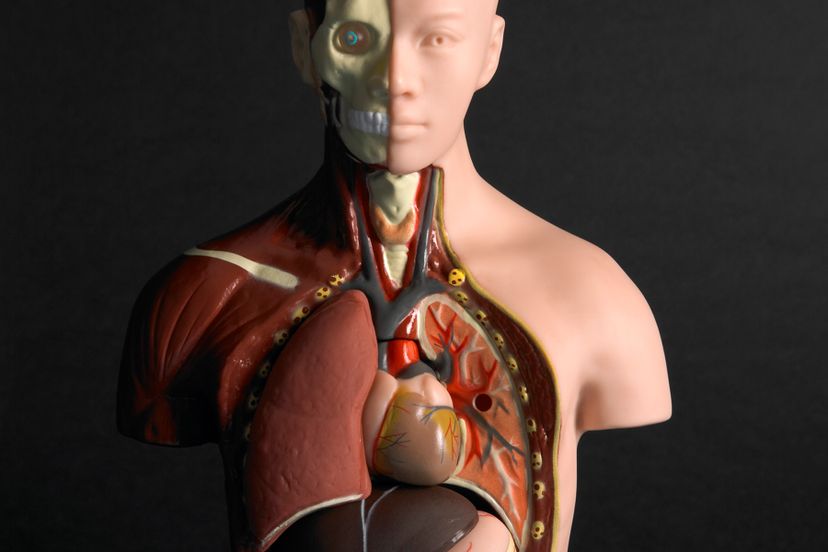
About This Quiz
If there's one thing we all know about our bodies, it's that they need healthy organs for us to exist comfortably. Organs are collections of tissues, nerves and blood vessels, each with their own role to perform in the functioning of our biology. When multiple organs work in a similar way, they then form organ systems. But before we go too far, we want to know how much you know about the body's organs.
We all know that the heart pumps blood, but do you know why it does that? The brain is the control center, but do you know just how many things it's in charge of? The stomach receives our food, but do you know what it does with it? We know the kidneys are our filtration system, but do you know what else they do?
If you didn't pay attention in biology class or weren't a pre-med major in college, you'll have to have quite the knowledge of the body to ace this quiz. If you're up to the challenge, who are we to stop you? Go ahead and prove to us that you know all about the human body and its organs in this quiz.
The pancreas releases insulin into the bloodstream, helping regulate blood sugar levels.
Skin is classified as an organ and is the largest organ of the human body. For an adult, skin can weigh eight pounds and measure 22 square feet.
The human heart uses four chambers to circulate blood through the body: the left atrium, right atrium, left ventricle and right ventricle.
Advertisement
While the spleen does function to filter blood and manage the immune system, humans can live without it. Other organs (e.g., the liver) take on the functions of a spleen when it is removed.
Ovaries are almond-size organs in the female pelvic cavity that produce eggs.
The gall bladder is located under the right lobe of the liver and stores bile for digestion. Bile is a yellow-green fluid that is excreted into the small intestine to break down fatty foods.
Advertisement
In addition to filtering blood, the liver produces important proteins like albumin.
The semicircular canals are located in the inner ear and contain hair cells that are activated by movement of fluid within each canal.
The nervous system includes ganglia and neurons and responds to internal as well as external stimuli.
Advertisement
The adrenal glands produce hormones that trigger the "fight or flight" response. These hormones (adrenaline and noradrenaline) increase blood pressure, heart rate and oxygen intake and prepare the body for action.
The human brain weighs an average of three pounds and is approximately 73 percent water. Attention, memory and other cognitive skills are affected by as little as a 2 percent drop in hydration.
The uterus is a muscular female organ located in the pelvis. It has a pre-pregnancy size of a pear, but during pregnancy can stretch to the size of a watermelon.
Advertisement
The trachea, bronchi and alveoli are all parts of the respiratory system.
The thyroid gland regulates metabolism and maturation of the human body.
The integumentary system, commonly known as skin, is made up of three main layers: the epidermis, dermis and the hypodermis.
Advertisement
As part of the urinary system, kidneys filter blood and produce urine.
The cochlea is an organ that translates sound into nerve impulses which are sent to the brain. Humans have two cochlea. They are snail-shaped caverns in the mastoid bones behind each ear.
The large intestine extracts moisture from food particles and excretes the unusable waste. The portion of the large intestine between the cecum and the rectum is called the colon.
Advertisement
At a length of approximately 20 feet, the small intestine is indeed the longest part of the digestive system.
The bladder is a muscular organ that stores urine before expelling it through the urethra.
The spleen filters out old as well as damaged red blood cells. The spleen can recycle useful components, such as iron, when the old cells are broken down.
Advertisement
Rod and cone cells are the two photoreceptors of the human eye. Rods are most sensitive to light and dark transitions as well as movement. Cones are sensitive to color.
The pineal gland is the smallest human organ, and it is located near the center of the brain. The pineal gland produces a hormone called melatonin, which affects how humans sleep.
Unilateral renal agenesis is a condition in which a person is missing a kidney at birth. Most people experience no symptoms or complications.
Advertisement
The endocrine system is made up of glands and secretes hormones to regulate a number of body functions.
The right lung is larger and heavier than the left. The left lung is smaller because of the position of the heart.
The stomach is a bean-shaped organ about the size of a fist. Food is swallowed through the esophagus and churned by the stomach before passing on to the small intestine.
Advertisement
An organ is defined as a group of tissues that perform a specific function or group of functions.
The small intestine contains the duodenum, jejunum and ileum. The primary functions of the small intestine are to digest food and absorb nutrients.
Carbon dioxide (not monoxide) and oxygen are exchanged in the lungs. Oxygen is inhaled into the lungs and carbon dioxide is exhaled.
Advertisement